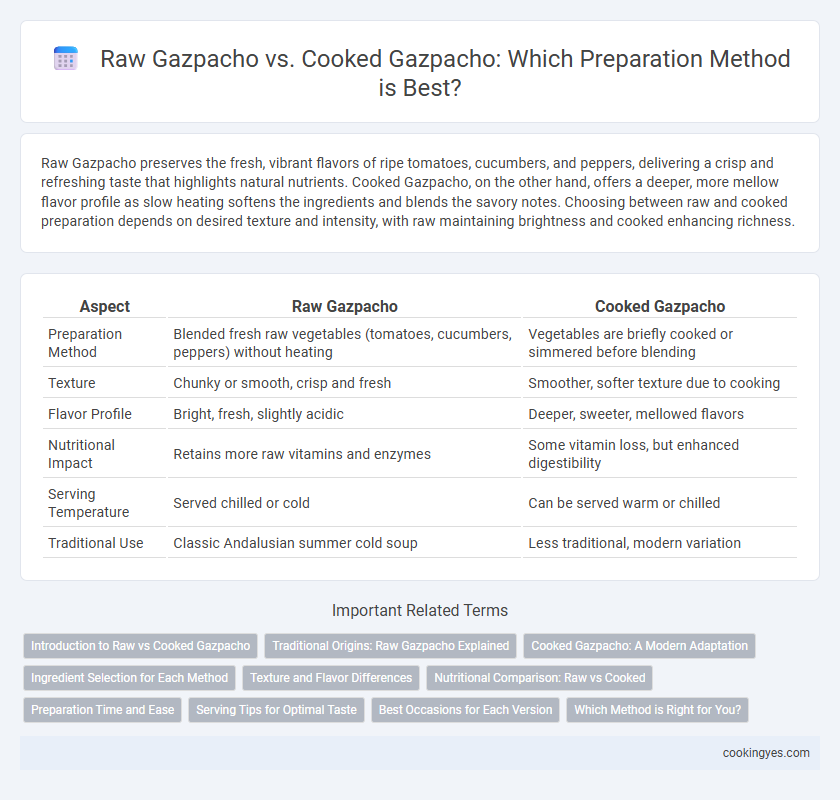Raw Gazpacho preserves the fresh, vibrant flavors of ripe tomatoes, cucumbers, and peppers, delivering a crisp and refreshing taste that highlights natural nutrients. Cooked Gazpacho, on the other hand, offers a deeper, more mellow flavor profile as slow heating softens the ingredients and blends the savory notes. Choosing between raw and cooked preparation depends on desired texture and intensity, with raw maintaining brightness and cooked enhancing richness.
Table of Comparison
| Aspect | Raw Gazpacho | Cooked Gazpacho |
|---|---|---|
| Preparation Method | Blended fresh raw vegetables (tomatoes, cucumbers, peppers) without heating | Vegetables are briefly cooked or simmered before blending |
| Texture | Chunky or smooth, crisp and fresh | Smoother, softer texture due to cooking |
| Flavor Profile | Bright, fresh, slightly acidic | Deeper, sweeter, mellowed flavors |
| Nutritional Impact | Retains more raw vitamins and enzymes | Some vitamin loss, but enhanced digestibility |
| Serving Temperature | Served chilled or cold | Can be served warm or chilled |
| Traditional Use | Classic Andalusian summer cold soup | Less traditional, modern variation |
Introduction to Raw vs Cooked Gazpacho
Raw gazpacho is a traditional cold Spanish soup made primarily from fresh, uncooked vegetables like tomatoes, cucumbers, and bell peppers, preserving their natural flavors and nutrients. Cooked gazpacho involves briefly heating or roasting some ingredients, which enhances depth and sweetness while slightly altering the texture and nutrient profile. Choosing between raw and cooked gazpacho affects preparation time, taste complexity, and nutritional content, with raw versions emphasizing freshness and crispness.
Traditional Origins: Raw Gazpacho Explained
Raw gazpacho preserves the authentic Andalusian tradition by using fresh, uncooked vegetables like tomatoes, cucumbers, and bell peppers blended with olive oil and vinegar. This preparation method emphasizes the vibrant flavors and nutritional benefits of raw ingredients, maintaining a refreshing and chilled texture that is characteristic of classic gazpacho. In contrast, cooked gazpacho involves simmering vegetables, which alters the flavor profile and softens the texture but deviates from the historic recipe rooted in southern Spain.
Cooked Gazpacho: A Modern Adaptation
Cooked gazpacho offers a modern adaptation by gently simmering ingredients to enhance flavor depth and create a thicker texture compared to traditional raw gazpacho. This preparation method intensifies the sweetness of tomatoes and softens vegetables, resulting in a warm, comforting dish that contrasts with the refreshing, chilled nature of raw gazpacho. Chefs favor cooked gazpacho for its versatility, allowing incorporation of spices and herbs that infuse during cooking, elevating the overall taste profile.
Ingredient Selection for Each Method
Raw gazpacho relies on fresh, high-quality vegetables such as ripe tomatoes, cucumbers, bell peppers, and onions, emphasizing crisp textures and bright, natural flavors. Cooked gazpacho incorporates softened ingredients, often roasting or simmering tomatoes and peppers to enhance sweetness and deepen taste profiles. The raw method benefits from firm, freshly picked produce, while the cooked version requires vegetables that withstand heat without losing essential nutrients or developing bitterness.
Texture and Flavor Differences
Raw gazpacho offers a crisp, refreshing texture with vibrant, fresh vegetable flavors preserved through its uncooked preparation. Cooked gazpacho, by contrast, delivers a smoother, more homogenized texture and a deeper, mellowed flavor profile due to the heat softening the ingredients and blending the taste. The choice between raw and cooked preparation directly impacts the soup's mouthfeel and intensity of flavor, catering to different culinary preferences.
Nutritional Comparison: Raw vs Cooked
Raw gazpacho preserves more vitamin C and antioxidants due to the absence of heat exposure, enhancing its nutritional profile compared to cooked versions. Cooking gazpacho can increase the bioavailability of certain antioxidants like lycopene but may reduce water-soluble vitamins such as vitamin B and vitamin C. Both versions offer unique health benefits, with raw gazpacho maximizing vitamin content and cooked gazpacho improving carotenoid absorption.
Preparation Time and Ease
Raw gazpacho offers a quicker preparation time, requiring only the blending of fresh vegetables without any cooking, making it ideal for fast, refreshing meals. Cooked gazpacho involves simmering ingredients, which extends the preparation time but can deepen flavors and improve ingredient integration. For ease, raw gazpacho is more straightforward, needing minimal kitchen equipment and no monitoring, while cooked gazpacho demands more attention and time at the stove.
Serving Tips for Optimal Taste
Raw gazpacho retains the fresh, vibrant flavors of raw vegetables, making it best served chilled immediately after preparation for a crisp and refreshing experience. Cooked gazpacho, softened through gentle heating, develops a deeper, richer taste and benefits from chilling to meld flavors before serving. Garnishing with fresh herbs, diced cucumbers, or a drizzle of high-quality olive oil enhances both versions, maximizing their distinct taste profiles.
Best Occasions for Each Version
Raw gazpacho is ideal for hot summer days and outdoor gatherings, offering a refreshing, cold soup rich in fresh vegetables and vibrant flavors. Cooked gazpacho suits cooler weather or indoor meals, providing a warm, comforting dish with blended ingredients that deepen in flavor through simmering. Each version complements different seasonal occasions, with raw gazpacho enhancing light, casual events and cooked gazpacho fitting hearty, family-style dinners.
Which Method is Right for You?
Raw gazpacho preserves the fresh, vibrant flavors of ripe tomatoes and garden vegetables, offering a cooler, nutrient-rich option ideal for hot weather. Cooked gazpacho, on the other hand, enhances depth and complexity through gentle heating, which can mellow acidity and blend flavors for a smoother texture. Choosing between raw and cooked gazpacho depends on personal preference for freshness versus warmth, as well as dietary goals and seasonal availability of ingredients.
Raw Gazpacho vs Cooked Gazpacho for Preparation Method Infographic

 cookingyes.com
cookingyes.com